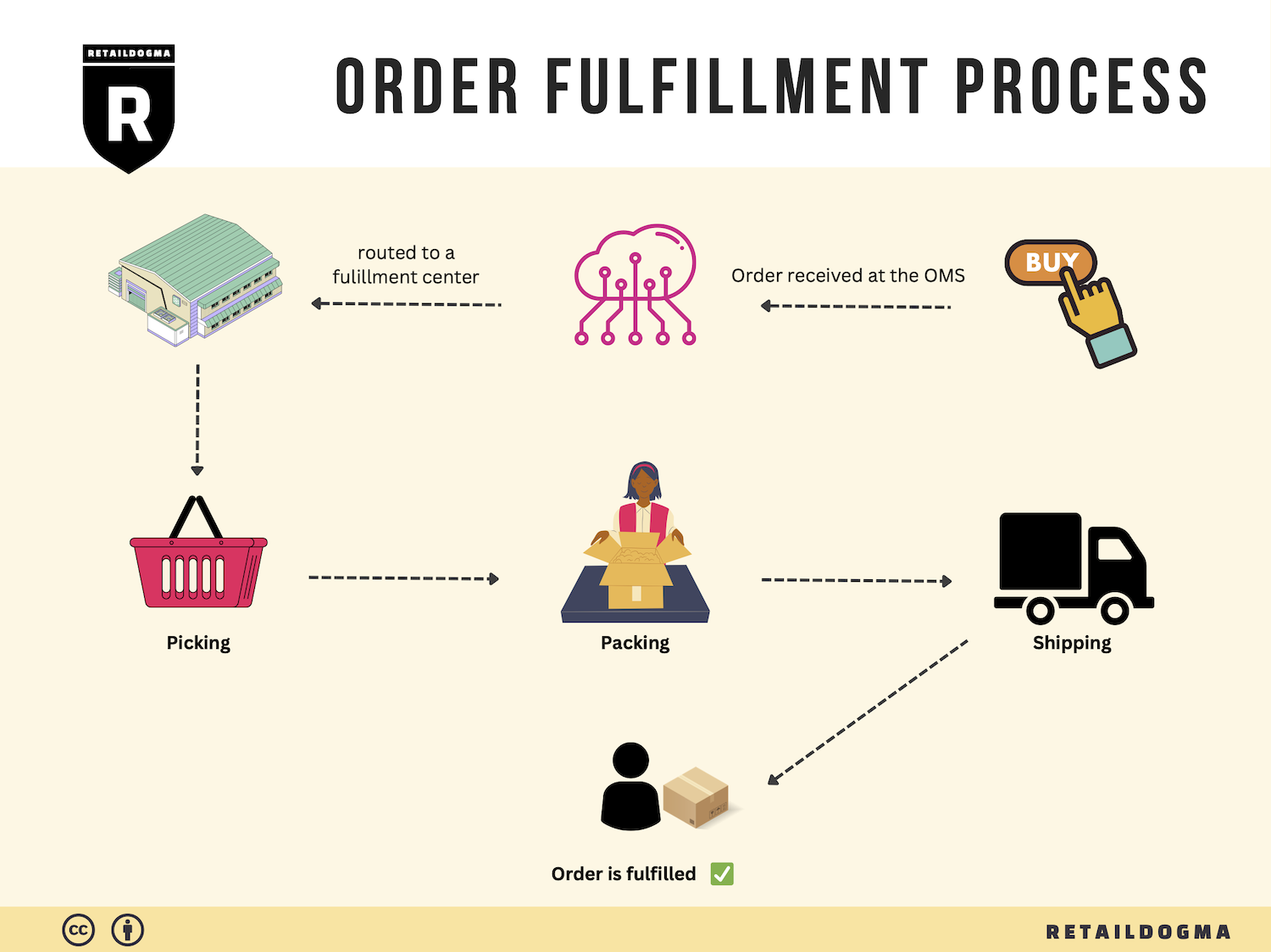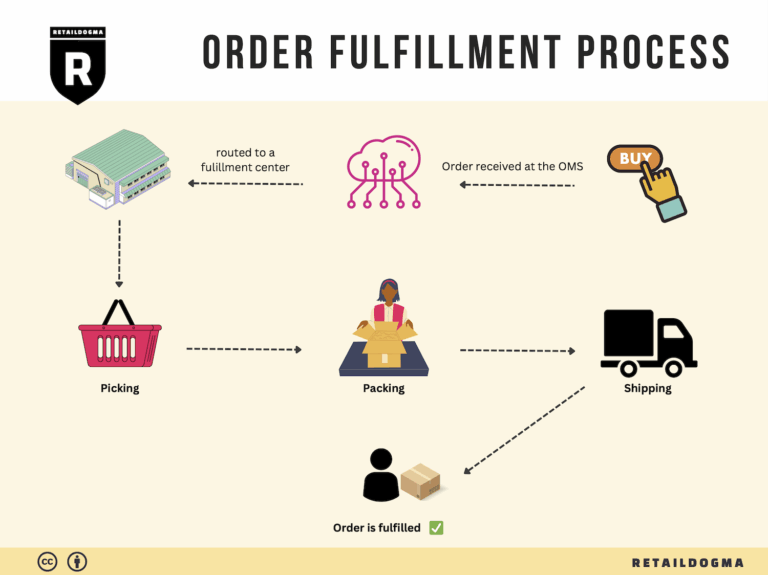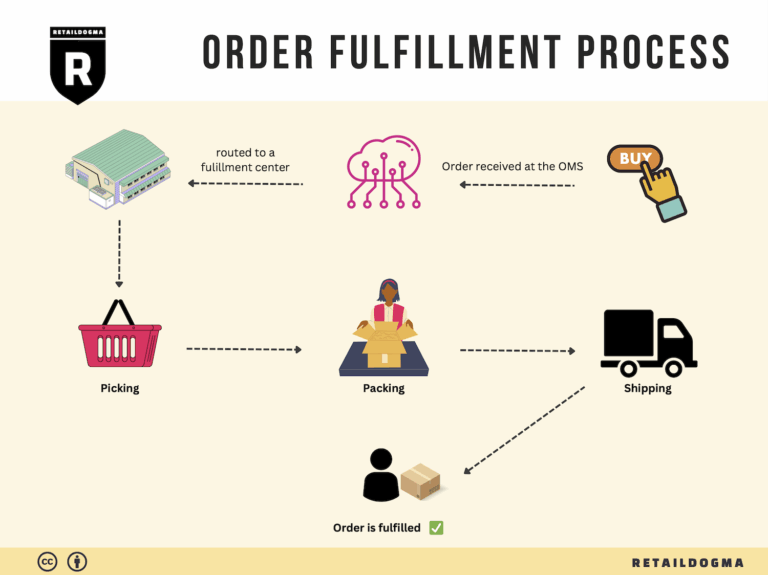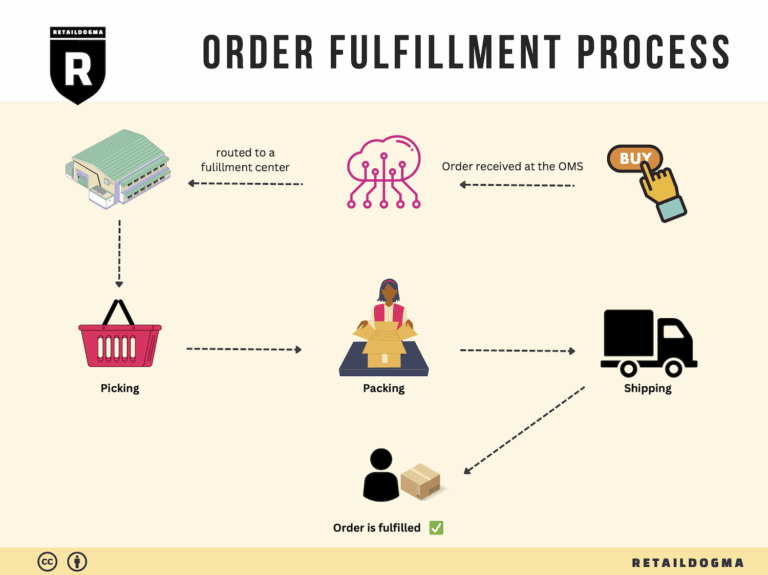How Order Fulfillment Works: A Step-by-Step Guide for Businesses
What is E-commerce Fulfillment? An Introduction for Growing Businesses
Understanding E-commerce Fulfillment: A Crucial Step for Growth
As your online business flourishes, the initial thrill of increasing sales can quickly be overshadowed by the logistical challenges of packing and shipping orders. Many growing e-commerce businesses find themselves overwhelmed by the complexities of fulfillment, struggling to maintain efficiency while ensuring customer satisfaction. This is where understanding e-commerce fulfillment becomes essential.
Fulfillment, at its core, is the process of getting a product from your inventory to your customer’s doorstep. It encompasses everything from receiving inventory, storing it, processing orders, picking and packing items, to shipping and handling returns. While these tasks may seem straightforward, they can become cumbersome and time-consuming as your business scales. This guide aims to demystify the fulfillment process and provide valuable insights for e-commerce business owners, operations managers, and entrepreneurs keen on scaling their logistics.
What This Guide Covers
In this comprehensive guide, we will explore various fulfillment models, including Third-Party Logistics (3PL) and Fulfillment by Amazon (FBA), to help you choose the best fit for your business needs. We will delve into core fulfillment services such as warehousing, inventory management, order processing, and returns management. Understanding these services will enable you to optimize your operations and enhance your customer experience.
Choosing the right fulfillment partner is critical for your business’s success. This guide will outline key considerations for selecting a logistics provider, including their technology capabilities, service offerings, and customer support. Additionally, we will discuss pricing structures in fulfillment, helping you understand costs associated with different models and services, ensuring you can budget effectively as you scale.
Empowering Your Business Decisions
Ultimately, the goal of this guide is to empower you to make informed decisions about your logistics and fulfillment strategies. By gaining a deeper understanding of the fulfillment landscape, you will be better equipped to streamline your operations, reduce overhead costs, and enhance customer satisfaction. Whether you’re looking to outsource your fulfillment or improve your in-house processes, this guide will serve as a roadmap to navigate the complexities of e-commerce fulfillment effectively.
Prepare to transform your logistics challenges into opportunities for growth and success in your e-commerce journey.
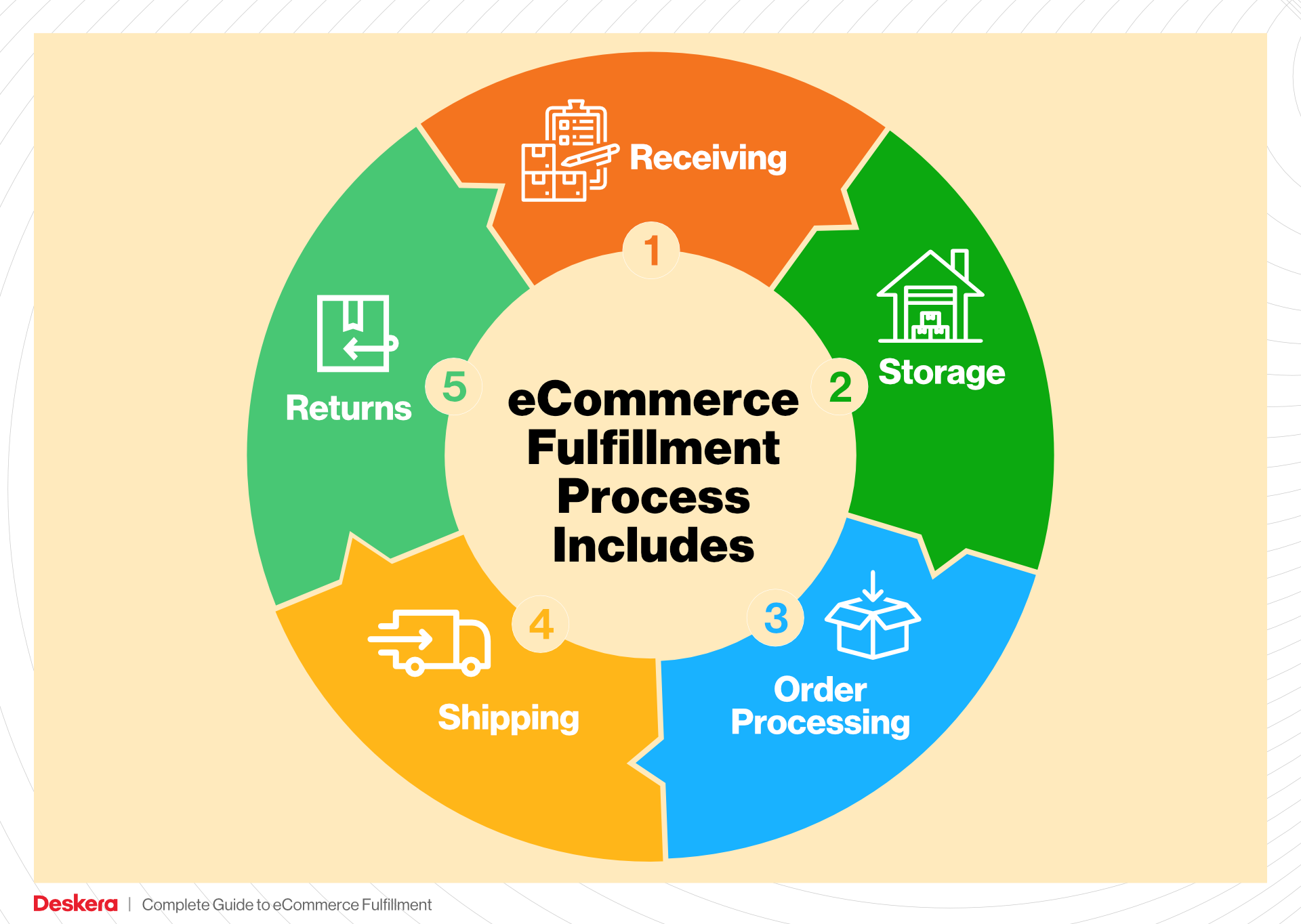
What You’ll Learn In This Guide
- What is E-commerce Fulfillment? An Introduction for Growing Businesses
- The Order Fulfillment Process: From ‘Buy’ Button to Customer’s Door
- Comparing Fulfillment Models: In-House vs. 3PL vs. Dropshipping
- A Deep Dive into Amazon FBA: Pros, Cons, and Who It’s For
- Core Services Offered by Fulfillment Centers
- How to Choose a Fulfillment Partner: A 6-Point Checklist
- Understanding Fulfillment Pricing: A Breakdown of Common Fees
- Frequently Asked Questions (FAQs) about Fulfillment
- Conclusion: Is Outsourcing Fulfillment the Right Move for Your Business?
- Important Disclaimer
The Order Fulfillment Process: From ‘Buy’ Button to Customer’s Door
1. Receiving Inventory
The order fulfillment process begins with receiving inventory, which involves the acceptance of goods from suppliers or manufacturers. During this stage, businesses must verify that the received products match the purchase orders in terms of quantity and quality. This verification process often utilizes Stock Keeping Units (SKUs), which serve as unique identifiers for each product, ensuring accurate tracking and management.
Why is this step important? Proper inventory receiving is crucial because it sets the foundation for the entire fulfillment process. Any discrepancies at this stage—such as damaged goods or incorrect quantities—can lead to fulfillment delays and customer dissatisfaction later on. By maintaining rigorous receiving protocols, e-commerce businesses can ensure that they start with an accurate inventory count, minimizing the risk of stockouts or overstock situations.
2. Warehouse Storage
Once inventory has been received and verified, the next step is warehouse storage. This involves organizing and storing the products within a warehouse in a manner that maximizes efficiency and accessibility. Effective warehousing utilizes techniques such as pallet stacking and continuous inventory organization, which ensure that products are stored in a way that optimizes space and minimizes retrieval time.
The importance of this step cannot be overstated. An organized warehouse reduces the time it takes to locate items, which directly impacts order processing speeds. Additionally, maintaining optimal storage conditions—such as temperature control for sensitive products—can preserve product quality and prevent losses. With a well-structured warehouse management system (WMS), businesses can maintain real-time visibility into stock levels and locations, facilitating better decision-making.
3. Order Picking
With inventory stored properly, the next step in the fulfillment process is order picking. This is the stage where warehouse staff retrieve items from storage based on customer orders. The efficiency of this process often relies on the use of pick lists, which are detailed documents that outline the items to be collected for each order, including their locations within the warehouse.
Order picking is a critical step, as it directly influences order accuracy and speed. Mistakes made during this phase—such as picking the wrong item or quantity—can lead to customer complaints and returns, which can be costly for businesses. By implementing systematic picking methods, such as batch picking or zone picking, companies can optimize this process and enhance their overall fulfillment efficiency. Furthermore, investing in technology, like handheld scanners or automated picking systems, can significantly reduce human error and improve productivity.
4. Order Packing
After items have been picked, they move to the order packing stage. This involves securely packaging the products for shipment, which is essential for protecting items during transit. Proper packing techniques include using appropriate box sizes, cushioning materials, and clear labeling with shipping information and barcodes.

The significance of this step lies in its impact on customer satisfaction. Well-packed orders minimize the risk of damage during delivery, ensuring that customers receive their products in pristine condition. Moreover, effective packing strategies can help control shipping costs by optimizing package dimensions and weight. Businesses should also consider implementing a returns processing strategy during packing, where return labels and instructions are included, making it easier for customers to return items if necessary.
5. Shipping & Delivery
The final step in the order fulfillment process is shipping and delivery. Once orders are packed, they are handed over to logistics partners for transportation to the customer’s doorstep. This stage encompasses various shipping options, including standard, expedited, and international shipping, and requires coordination with carriers to ensure timely delivery.
This step is vital because it represents the last interaction between the customer and the business. Efficient shipping processes contribute to positive customer experiences and can lead to repeat business. Utilizing technology to track shipments in real-time provides transparency for customers, allowing them to monitor their orders and anticipate delivery times. Additionally, effective transportation management can help businesses negotiate better rates and improve their overall shipping strategy.
In summary, understanding and optimizing each step of the order fulfillment process—from receiving inventory to shipping and delivery—can significantly enhance operational efficiency and customer satisfaction for e-commerce businesses. By paying attention to each phase, businesses can better scale their logistics operations and meet the growing demands of their customer base.
Comparing Fulfillment Models: In-House vs. 3PL vs. Dropshipping
Fulfillment Model Comparison
| Model | Who Handles Inventory | Best For (Business Stage) | Key Advantage | Key Disadvantage |
|---|---|---|---|---|
| In-House Fulfillment | The business itself | Startups to Established | Greater control over operations | High overhead costs and resource demands |
| Third-Party Logistics (3PL) | A third-party logistics provider | Established to Scaling | Scalability and expertise in logistics | Less control over inventory and processes |
| Dropshipping | Supplier or manufacturer | Startups and Small Businesses | Low initial investment and risk | Longer shipping times and potential stock issues |
In-House Fulfillment
In-house fulfillment refers to a model where a business manages its own storage, inventory, and shipping processes. This approach is ideal for companies that have the resources and desire to maintain direct control over every aspect of their fulfillment operations. By handling inventory internally, businesses can ensure quality control, customize packaging, and respond quickly to customer inquiries and order changes. This model is best suited for startups that have established a viable product-market fit or for larger businesses that can afford to invest in warehousing and logistics infrastructure. However, the key disadvantage of in-house fulfillment lies in its high overhead costs. Businesses need to invest in warehouse space, hire staff, and maintain technology systems, which can be burdensome, especially for smaller operations. Moreover, the demands of managing logistics can distract business owners from focusing on growth and customer engagement.
Third-Party Logistics (3PL)
Third-party logistics (3PL) providers offer comprehensive services that include warehousing, inventory management, and distribution. This model is particularly advantageous for established businesses looking to scale without the burden of managing logistics in-house. By outsourcing fulfillment to a 3PL, companies can leverage the provider’s expertise, technology, and extensive networks to streamline their operations and reduce costs. 3PLs often have advanced warehouse management systems (WMS) that provide real-time visibility into inventory levels and order statuses, improving overall efficiency. The key disadvantage of using a 3PL is the potential loss of control over inventory and fulfillment processes. Businesses may face challenges in communication, especially if the 3PL does not align with their operational standards or customer service expectations. Additionally, businesses must ensure that they choose a reliable 3PL partner to avoid issues related to shipping errors and inventory discrepancies.
Dropshipping
Dropshipping is a fulfillment model where the retailer does not hold inventory but instead transfers customer orders directly to a supplier or manufacturer, who then ships the products directly to the customer. This model is particularly appealing for startups and small businesses due to its low initial investment and minimal risk. Retailers can offer a wide range of products without the need for significant capital to purchase and store inventory. This flexibility allows businesses to experiment with different products and market trends without being tied down by inventory costs. However, dropshipping comes with its challenges. One of the main drawbacks is the longer shipping times, as products often have to travel from the supplier to the customer, which can lead to dissatisfaction if not managed properly. Additionally, retailers may face issues with stock availability, as they rely on suppliers to maintain inventory levels. This dependency can lead to a lack of control over the customer experience, which is crucial for maintaining brand reputation.
In conclusion, the choice of fulfillment model depends on various factors including business stage, available resources, and strategic goals. Each model has its distinct advantages and disadvantages, and businesses must carefully assess their needs and capabilities before deciding on the most suitable approach. By understanding the nuances of in-house fulfillment, 3PL, and dropshipping, e-commerce business owners can make informed decisions that align with their growth objectives and customer expectations.
A Deep Dive into Amazon FBA: Pros, Cons, and Who It’s For
Understanding Fulfillment by Amazon (FBA)
Fulfillment by Amazon (FBA) is a service provided by Amazon that allows e-commerce sellers to store their products in Amazon’s fulfillment centers. Amazon then takes care of storage, packaging, and shipping of the products directly to the customers. This service not only simplifies logistics for sellers but also leverages Amazon’s vast distribution network and customer trust.
When a customer places an order for a product fulfilled by Amazon, the process is automated. Amazon picks the product from the warehouse, packages it, and ships it to the customer. Additionally, Amazon handles all customer service inquiries and returns for those orders, allowing sellers to focus on other aspects of their business.
How FBA Works
-
Setting Up Your FBA Account: To start using FBA, sellers must create an Amazon Seller Account and enroll in the FBA program. This process involves agreeing to Amazon’s terms and conditions and setting up shipping options.
-
Sending Inventory to Amazon: Once registered, sellers prepare their products for shipment to Amazon’s fulfillment centers. This includes labeling products according to Amazon’s guidelines, packaging them securely, and creating a shipment plan in the seller dashboard.
-
Storage and Fulfillment: After the products arrive at the fulfillment center, Amazon stores them until a customer places an order. When an order is received, Amazon picks, packs, and ships the product. The seller is notified about the sale, and the inventory is automatically adjusted.
-
Customer Service and Returns: Amazon manages all customer interactions regarding the product, including inquiries, shipping updates, and return processing. This relieves sellers from the burden of customer service, allowing them to focus on growth.
Pros of Amazon FBA
-
Prime Eligibility: Products fulfilled through FBA automatically qualify for Amazon Prime, making them more attractive to millions of Prime members who prefer fast, free shipping. This can significantly increase sales, as many customers filter search results to show only Prime-eligible products.
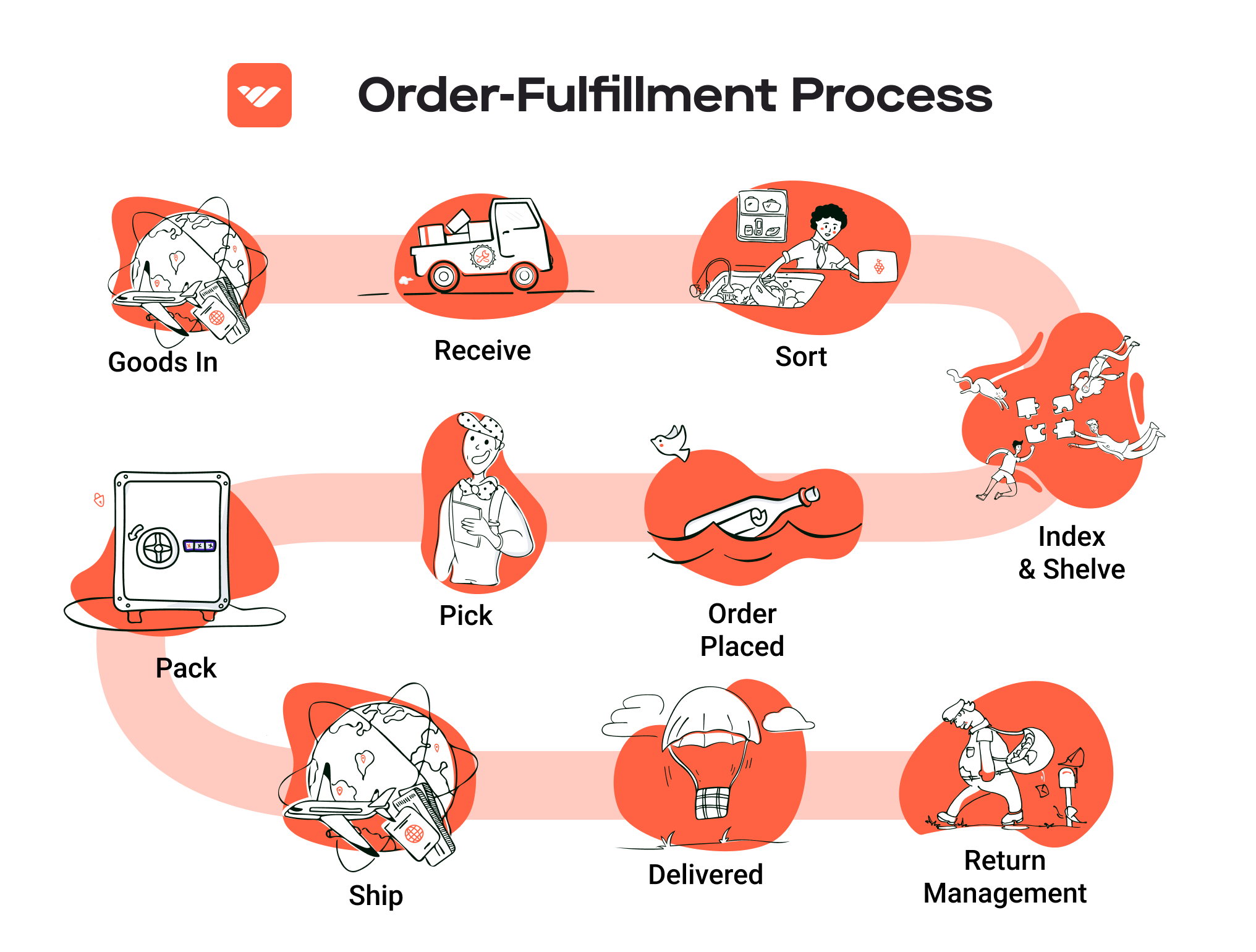
-
Customer Trust: Leveraging Amazon’s reputation for reliability and customer service, FBA sellers benefit from increased consumer trust. Buyers are more likely to purchase from a seller whose products are backed by Amazon’s customer service and return policies.
-
Multi-Channel Fulfillment: FBA is not limited to Amazon’s marketplace. Sellers can also use FBA to fulfill orders from their own websites or other sales channels, streamlining inventory and logistics across multiple platforms.
-
Reduced Operational Burden: With Amazon handling storage, shipping, and customer service, sellers can focus on marketing, product development, and scaling their businesses without getting bogged down in logistics.
-
Scalability: FBA allows sellers to scale their operations easily. As sales grow, sellers can send larger quantities of products to Amazon without needing to invest in additional warehousing or logistics infrastructure.
Cons of Amazon FBA
-
High Fees: While FBA provides many benefits, it comes at a cost. Sellers incur various fees, including storage fees for holding products in Amazon’s warehouses and fulfillment fees for picking, packing, and shipping items. These costs can eat into profit margins, particularly for low-priced items.
-
Strict Inventory Rules: Amazon has stringent inventory management policies. Sellers must adhere to specific guidelines regarding product labeling, packaging, and inventory limits. Failure to comply can result in additional fees or even account suspension.
-
Commingling Risks: Amazon’s policy of commingling inventory means that products from different sellers may be mixed together in the same warehouse. This can lead to issues where a seller’s product might be replaced with a defective or counterfeit item, impacting their reputation and customer satisfaction.
-
Loss of Control: By using FBA, sellers relinquish some control over the fulfillment process. They are dependent on Amazon’s systems and processes, which can sometimes lead to inefficiencies or errors outside of the seller’s control.
-
Complex Return Handling: While Amazon manages returns, the process may not always be favorable for sellers. Returned items may be sent back in poor condition, or Amazon may choose to dispose of unsellable items without consulting the seller.
Who is FBA Best For?
Fulfillment by Amazon is an excellent option for various types of sellers:
-
Small to Medium-Sized Businesses: For businesses that lack the resources to manage their own warehousing and fulfillment, FBA offers a cost-effective way to leverage Amazon’s infrastructure.
-
E-commerce Startups: New sellers can quickly establish an online presence without heavy investments in logistics. FBA allows them to focus on marketing and sales while Amazon handles fulfillment.
-
Sellers with High Sales Volume: Businesses that experience rapid growth or have seasonal spikes in demand can benefit from FBA’s scalability, making it easier to meet customer expectations.
-
Brands Seeking Exposure: Sellers looking to increase their visibility on Amazon can benefit from Prime eligibility and Amazon’s vast customer base, enhancing their chances of higher sales.
-
Businesses with Limited Logistics Experience: Sellers who are not well-versed in shipping, handling, and customer service can utilize FBA to simplify these processes and minimize operational headaches.
In summary, while FBA presents several advantages in terms of convenience and access to Amazon’s vast customer base, potential sellers must carefully weigh the associated costs and restrictions. By understanding these dynamics, businesses can determine if FBA aligns with their operational goals and growth strategies.
Core Services Offered by Fulfillment Centers
Inventory Management & Warehousing
Inventory management and warehousing are foundational services provided by fulfillment centers, crucial for e-commerce businesses aiming to optimize their supply chain. This service encompasses the storage, organization, and tracking of products within a fulfillment center’s facility.
Fulfillment centers utilize advanced Warehouse Management Systems (WMS) to provide real-time visibility into inventory levels, automate stock replenishment, and streamline order processing. This technology enables businesses to keep track of their stock across multiple locations, reducing the risk of overstocking or stockouts, which can significantly impact sales and customer satisfaction.
Benefits:
– Enhanced Efficiency: Automated systems reduce manual errors and improve the speed of inventory management.
– Cost Savings: By optimizing storage space and reducing excess inventory, businesses can lower warehousing costs.
– Better Decision-Making: Access to real-time data allows for informed decisions regarding purchasing and inventory levels, aiding in demand forecasting.
Pick and Pack Services
Pick and pack services are essential for ensuring that customer orders are fulfilled accurately and efficiently. This process involves selecting the right products from the warehouse shelves (picking) and then packaging them appropriately for shipment (packing).
Fulfillment centers often have dedicated teams and systems in place to handle this process, ensuring that orders are fulfilled quickly and accurately. With advanced order management systems, businesses can track orders in real-time, ensuring timely deliveries that meet customer expectations.
Benefits:
– Increased Accuracy: Systems and trained staff reduce the likelihood of picking errors, enhancing customer satisfaction.
– Faster Turnaround: Efficient pick and pack operations mean that orders are processed more quickly, allowing for same-day or next-day shipping.
– Scalability: As businesses grow, fulfillment centers can easily scale their pick and pack operations to meet increased demand without the need for additional resources.
Kitting and Assembly
Kitting and assembly services involve grouping individual items together to create a single product or kit, which can be especially useful for promotional packages or product bundles. This service can also extend to assembling products that require multiple components before they are shipped to customers.
Fulfillment centers that offer kitting and assembly help streamline the order fulfillment process by preparing products in advance, making it easier to manage complex orders and improving efficiency.
Benefits:
– Value Addition: Kitting allows businesses to offer unique product bundles, enhancing customer appeal and potentially increasing average order value.
– Streamlined Operations: By preparing kits in advance, businesses can reduce the time spent on individual order assembly during peak times.
– Flexibility: Kitting services can be tailored to meet specific promotional or seasonal needs, allowing businesses to adapt quickly to market trends.
Returns Management (Reverse Logistics)
Returns management, also known as reverse logistics, is a critical service that handles product returns from customers back to the fulfillment center. This process includes receiving returned items, assessing their condition, restocking them if possible, and managing any necessary repairs or replacements.
Effective returns management is essential in e-commerce, where return rates can be high. A fulfillment center’s ability to efficiently process returns can significantly impact customer satisfaction and retention.
Benefits:
– Enhanced Customer Experience: A smooth returns process improves customer trust and satisfaction, encouraging repeat business.
– Operational Efficiency: By managing returns effectively, businesses can minimize losses associated with returned merchandise and streamline restocking processes.
– Data Insights: Returns management provides valuable data on product performance and customer preferences, enabling businesses to make informed decisions about inventory and product offerings.
In conclusion, the core services offered by fulfillment centers—inventory management and warehousing, pick and pack services, kitting and assembly, and returns management—are integral to the success of e-commerce businesses. By leveraging these services, companies can improve efficiency, reduce costs, and enhance customer satisfaction, ultimately driving growth and scalability in a competitive market.
How to Choose a Fulfillment Partner: A 6-Point Checklist
Location & Warehouse Network
The geographical location of your fulfillment partner’s warehouses can significantly impact shipping times and costs. A partner with warehouses strategically located near your customer base can reduce transit times and improve customer satisfaction.
Questions to Ask:
– Where are your warehouses located, and how does this align with our customer demographics?
– Do you have multiple locations to facilitate faster shipping across regions?
– What is your average shipping time to key areas where our customers are located?
Technology & Integrations
In today’s digital landscape, a fulfillment partner’s technology capabilities are crucial. A robust Warehouse Management System (WMS) should provide real-time inventory tracking, order processing, and integrations with your e-commerce platform.
Questions to Ask:
– What technology platforms do you use for inventory management and order fulfillment?
– Can your system integrate seamlessly with our e-commerce platform (e.g., Shopify, WooCommerce)?
– What kind of reporting and analytics do you provide for tracking our inventory and order status?
Specializations (e.g., Cold Storage, Oversized Items)
Depending on your product types, you may need a fulfillment partner that specializes in specific areas, such as cold storage for perishable items or handling oversized products.
Questions to Ask:
– What types of products do you specialize in handling?
– Do you have the capability to store and ship items that require temperature control?
– How do you manage the logistics for oversized or fragile items?
Scalability & Capacity
As your business grows, your fulfillment partner must be able to scale operations to meet increasing demand. Assessing their capacity to handle seasonal spikes and long-term growth is essential.
Questions to Ask:
– How do you manage seasonal fluctuations in order volume?
– What is your capacity for scaling operations, and how quickly can you accommodate increased demand?
– Can you provide examples of how you have successfully scaled for other clients?
Pricing and Contracts
Understanding the pricing structure and contract terms is vital for budgeting and avoiding unexpected costs. A transparent pricing model can help you forecast fulfillment expenses more accurately.
Questions to Ask:
– What is your pricing structure, and what factors influence your rates?
– Are there any hidden fees, such as for storage, handling, or returns?
– What are the terms of your contract, and what is your policy on contract termination?
Customer Support & Reviews
Reliable customer support is essential for addressing any issues that may arise during the fulfillment process. Additionally, researching reviews and testimonials can provide insight into the partner’s reliability and service quality.
Questions to Ask:
– What customer support channels do you offer (e.g., phone, email, chat)?
– How quickly can we expect a response to support inquiries?
– Can you provide references or case studies from similar businesses that you have worked with?
Conclusion
Choosing the right fulfillment partner is a crucial decision that can significantly impact your e-commerce operations. By considering these six key points—location and warehouse network, technology and integrations, specializations, scalability, pricing, and customer support—you can make a more informed choice that aligns with your business needs and growth objectives. Always ensure that your potential partner not only meets your current requirements but can also adapt as your business evolves.
Understanding Fulfillment Pricing: A Breakdown of Common Fees
Initial Setup Fees
Initial setup fees are typically charged by fulfillment centers to cover the costs associated with onboarding a new client. This fee can vary significantly based on the complexity of your operations and the specific services you require. Factors influencing the initial setup fee include the integration of your e-commerce platform with the fulfillment center’s systems, the customization of workflows, and the training of your team to use the new systems effectively.
Some fulfillment providers may waive these fees during promotional periods or for long-term contracts, so it’s essential to inquire about any current offers that could reduce or eliminate this cost.
Receiving Fees
Receiving fees are charged when your inventory arrives at the fulfillment center. This fee compensates the facility for the labor and equipment needed to unload, inspect, and store your products. Costs can vary based on several factors, including:
- Volume of Inventory: Larger shipments may incur higher fees due to the extra time and resources required to process them.
- Type of Products: Fragile or complex items that require special handling can lead to increased receiving fees.
- Documentation: Incomplete or incorrect shipping documents may also result in additional charges due to the extra time needed to resolve discrepancies.
Understanding the receiving fee structure will help you plan your inventory shipments more efficiently.
Storage Fees (per pallet/bin)
Storage fees are charged for the space your inventory occupies within the fulfillment center. These fees are typically calculated on a per-pallet or per-bin basis and can vary based on:
- Duration of Storage: Longer storage times can lead to higher cumulative fees, so it’s crucial to have a strategy for inventory turnover.
- Location within the Warehouse: Some fulfillment centers charge different rates for premium storage locations that offer quicker access to high-demand items.
To manage storage costs effectively, regularly review your inventory levels and sales forecasts to minimize excess stock and optimize storage space.
Pick & Pack Fees (per item/order)
Pick and pack fees are incurred each time an order is processed. This fee covers the labor involved in selecting items from storage and packing them for shipment. The calculation is generally straightforward:
- Per Item Fee: You may be charged a flat rate for each item picked and packed, which can vary based on the complexity of the order.
- Order Complexity: Orders that require special packing materials, multiple items, or additional handling can attract higher fees.
To reduce pick and pack costs, consider consolidating orders or utilizing simpler packaging options.
Shipping Fees
Shipping fees encompass the costs associated with transporting your products to customers. These fees can be influenced by several factors, including:
- Shipping Method: Options range from standard ground services to expedited shipping, each with different price points.
- Destination: Shipping costs can vary based on the distance to the delivery address, with international shipping often incurring additional customs fees.
- Package Size and Weight: Heavier and larger packages typically result in higher shipping fees, so optimizing packaging can help reduce costs.
Many fulfillment centers offer negotiated rates with carriers, which can lead to significant savings. Understanding the various shipping options available to you can help you provide better service to your customers while managing costs.
Tips for Getting an Accurate Quote
-
Be Detailed: Provide as much information as possible about your products, order volume, and expected growth. This information will help fulfillment centers tailor their quotes to your specific needs.
-
Ask About Additional Fees: Inquire about any potential hidden fees, such as those for returns, special handling, or seasonal surcharges, to avoid surprises later on.
-
Compare Multiple Providers: Request quotes from several fulfillment centers to compare pricing structures and services. This will help you identify the best value for your business.
-
Negotiate: Don’t hesitate to negotiate terms, especially if you are committing to a long-term contract. Many providers are willing to adjust fees to secure your business.
-
Review Contracts Carefully: Before signing, ensure you understand all terms and conditions, including fee structures, service levels, and any penalties for non-compliance.
By understanding these common fulfillment pricing models and following these tips, you can make informed decisions that align with your business goals and budget.
Frequently Asked Questions (FAQs) about Fulfillment
1. What is fulfillment in e-commerce?
Fulfillment in e-commerce refers to the complete process of receiving, processing, and delivering orders to customers. This includes inventory management, order picking and packing, shipping, and handling returns. A smooth fulfillment process is crucial for customer satisfaction and can significantly impact your business’s reputation.
2. What’s the difference between a warehouse and a fulfillment center?
A warehouse is primarily used for storing inventory, while a fulfillment center is designed specifically for processing orders and distributing products to customers. Fulfillment centers often include additional services such as picking, packing, shipping, and returns management to support e-commerce operations.
3. What is a 3PL (Third-Party Logistics)?
A 3PL (Third-Party Logistics) provider offers outsourced logistics services, including transportation, warehousing, and fulfillment. By partnering with a 3PL, e-commerce businesses can leverage their expertise and infrastructure to streamline operations, reduce costs, and focus on core business activities.
4. How much do fulfillment services cost?
The cost of fulfillment services varies based on several factors, including order volume, storage space required, and specific services needed (like kitting or returns management). Generally, businesses can expect to pay for storage per cubic foot, fulfillment per order, and additional fees for special services. It’s advisable to request quotes from multiple providers to compare pricing.
5. How can I ensure accurate order fulfillment?
To ensure accurate order fulfillment, implement a robust Warehouse Management System (WMS) that provides real-time inventory tracking and order management. Regular training for staff, systematic quality checks, and efficient picking and packing processes are also critical for maintaining accuracy.
6. What are the benefits of outsourcing fulfillment?
Outsourcing fulfillment allows businesses to reduce overhead costs, access advanced technology and expertise, and scale operations efficiently. It enables e-commerce owners to focus on marketing and customer engagement while leaving logistics management to specialized providers.
7. How do I choose the right fulfillment partner?
When selecting a fulfillment partner, consider factors such as their experience in your industry, technology capabilities, scalability, geographical reach, and customer service. Request references, review client testimonials, and evaluate their ability to meet your specific fulfillment needs.
8. What is the typical turnaround time for order fulfillment?
Turnaround times can vary based on the fulfillment center’s processes and your specific requirements. However, many fulfillment centers offer same-day processing for orders received before a certain cut-off time. Always clarify these timelines with potential partners to ensure they align with your business needs.
9. How do fulfillment centers handle returns?
Fulfillment centers typically have a dedicated returns management process, which includes inspecting returned items, restocking them in inventory, and updating inventory records. Efficient returns processing is essential for maintaining customer satisfaction and managing costs effectively.
10. Can I integrate my e-commerce platform with a fulfillment provider?
Yes, most modern fulfillment providers offer integration capabilities with popular e-commerce platforms through APIs. This integration allows for seamless data transfer, enabling you to track inventory levels, process orders, and manage returns efficiently from a single dashboard. Be sure to confirm integration options when choosing a fulfillment partner.
Conclusion: Is Outsourcing Fulfillment the Right Move for Your Business?
Evaluating the Benefits of Outsourcing Fulfillment
Outsourcing fulfillment can be a transformative decision for e-commerce businesses aiming to scale efficiently. By leveraging the expertise of specialized fulfillment partners, companies can significantly save time, allowing them to focus on core business activities such as marketing, product development, and customer engagement. Fulfillment centers offer streamlined processes that improve order accuracy and speed, reducing the burden of daily operations.
Scalability is another compelling advantage. As your business grows, so do your logistics demands. A reliable fulfillment partner can adapt to fluctuating order volumes without the need for extensive capital investment in infrastructure. This flexibility ensures that you can meet customer expectations, even during peak seasons, without compromising service quality.
Additionally, partnering with a fulfillment service brings access to industry expertise and advanced technologies. Fulfillment providers utilize sophisticated warehouse management systems that provide real-time inventory visibility, automate order processing, and enhance overall operational efficiency. This not only improves customer satisfaction through timely deliveries but also mitigates risks associated with inventory management.
However, selecting the right fulfillment partner is crucial for sustainable growth. Assessing their capabilities, technology, and customer service can make a significant difference in your operational success.
Take Action
As you consider the potential benefits of outsourcing your fulfillment, take a moment to audit your current shipping process. Identify pain points and opportunities for improvement. Ask yourself: Are you equipped to handle growth? Is your fulfillment process hindering your business’s potential? If you find gaps that a fulfillment partner could address, it may be time to explore options that align with your vision for growth. Your next step could be the key to unlocking greater efficiency and enhancing customer satisfaction.
Important Disclaimer
⚠️ Important Disclaimer
The information in this guide is for educational purposes. Fulfillment services, pricing, and platform features change frequently. Always conduct your own due diligence and consult with providers directly before making business decisions.
